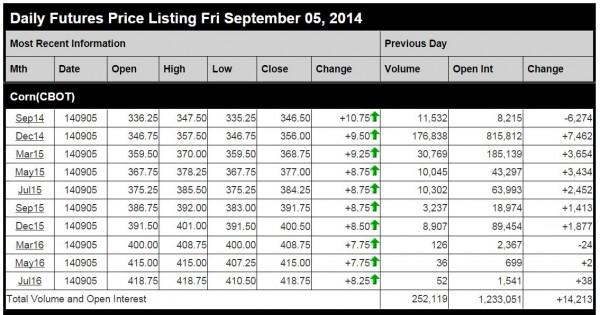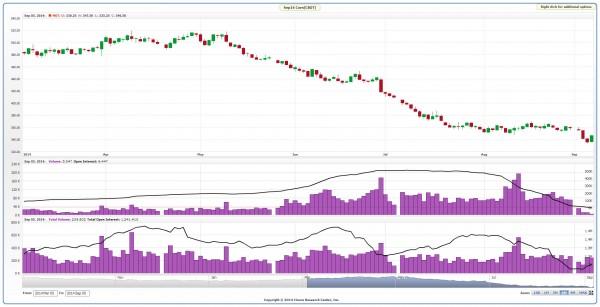Open Interest is an indicator that calculates the number of Futures contracts that have been entered into, but have not yet been offset or delivered against.
As a day trader you may enter the market with a purchase of a Futures contract. To offset your position you simply need to sell this same Futures contract at a later time in the day. Your transaction will increase volume for that day, but will have no impact on open interest.
For a swing trader or investor they will be holding positions overnight. By creating a Futures contract they will also increase volume for that trading session, but because they have not offset their position yet and will be holding the position overnight they will increase open interest by the number of contracts they are holding.
Open interest gets a little more confusing when calculating the change in this indicator. The following events will have an impact on open interest:
If both traders are initiating a new position (one new buyer and one new seller), open interest will increase by one
If both traders are off-setting their positions (one old buyer and one old seller), then open interest will decrease by one
If a trader exits their old position and a new trader is on the other side (one old seller buys from a new seller) or (one old buyer sells to a new buyer), either of these events will cause open interest to remain unchanged
As an indicator a trader can use open interest to look for divergence in price and open interest after extended periods of a trending market. For example, if the market is trending higher in price and open interest fails to make new highs with the new price highs this could be a divergence that signals the trend may be ending.
Open interest is also used to analyze the weekly Commitment of Traders report (COT) that is released by the Commodity Futures Trading Commission (CFTC).
I would like to discuss the proper way to locate open interest for traders wishing to pursue the understanding of this indicator. This indicator is available on most charting packages. However, most charting packages give us the wrong open interest indicator to use.
The two types of open interest that are available are called:
Contract Specific
Cumulative
Figure 1 is a snapshot of Moore Research’s (www.mrci.com) end of day prices. These are available for free on their website. I would like to thank MRCI for permission to use their data for this article.
I chose Corn due to the time of the year and contract expiration. Most speculators would not be trading the September contract due to the lower volume each year this contract month has.
To find contract specific open interest you would look across the line where Sep14 is displayed until you come to the column Open Int. The number (8,215) you see is the number of open contracts in the contract expiring in September 2014. Therefore this is only referencing the open interest for this specific month – Contract Specific.
To find cumulative open interest you would look at the bottom of Figure 1 and locate “Total Volume and Open Interest”. Scroll across until you find the Open Int column and you will find the number (1,233,051) representing all of the Corn contracts traded open interest – Cumulative Open Interest.
Figure 2 is a free chart that is available from MRCI as well when you click on the link of the contracts listed in Figure 1. For example, if you were to go to their website and click on Sep14 the link will take you to this chart.
With Figure 2 I would like to show you why we only want to use cumulative open interest for our analysis of the markets.
Price for the Sep14 Corn contract is represented by the candles. Below the candles you see two windows. Both have purple vertical bars representing the daily volume and a black line representing the open interest.
The top window is contract specific and the lower window is the cumulative window.
If a trader were going to use open interest to find a divergence in price then the indicator they would want to use is the lower window. Notice how the black line moves up and down with the candles above it. We can see the traders entering the market with new positions as the line ascends and we can see the traders leaving their positions as the black line descends. We can now find potential divergences on this window that could signal a trend change. This is because we are tracking cumulative open interest and not contract specific in the lower window.
The upper window is plotting the contract specific open interest. Notice on the left of the chart how low the volume and open interest are. This is because on those dates there was another front month contract where the majority of volume was trading. As September came closer to being a front month the majority of volume and open interest came into this contract as seen by the rising volume and black line around June 30 when the July14 contract was getting First Notice Day.
But notice on the right side of the chart how the open interest starts to drop off just as fast near the end of August. This is First Notice Day for the September contract and speculators would be forced out of this specific contract or face taking delivery. So the open interest line in a contract specific window is only following the contract as it becomes the new front month and then as it goes into expiration tracks traders leaving that contract. This does not give a trader any valuable information about the strength or weakness of the overall Corn market.
When using the open interest indicator a trader would find it much more beneficial to use the cumulative open interest indicator. Many of our chart packages only give the contract specific open interest. This is why I use the MRCI free website when I want to see the cumulative open interest.
“Happy are those who dream dreams and are ready to pay the price to make them come true.” Lean Suenens
This content is intended to provide educational information only. This information should not be construed as individual or customized legal, tax, financial or investment services. As each individual's situation is unique, a qualified professional should be consulted before making legal, tax, financial and investment decisions. The educational information provided in this article does not comprise any course or a part of any course that may be used as an educational credit for any certification purpose and will not prepare any User to be accredited for any licenses in any industry and will not prepare any User to get a job. Reproduced by permission from OTAcademy.com click here for Terms of Use: https://www.otacademy.com/about/terms
Editors’ Picks

USD/JPY pops and drops on BoJ's expected hold
USD/JPY reverses a knee-jerk spike to 142.80 and returns to the red below 142.50 after the Bank of Japan announced on Friday that it maintained the short-term rate target in the range of 0.15%-0.25%, as widely expected. Governor Ueda's press conference is next in focus.

AUD/USD bears attack 0.6800 amid PBOC's status-quo, cautious mood
AUD/USD attacks 0.6800 in Friday's Asian trading, extending its gradual retreat after the PBOC unexpectedly left mortgage lending rates unchanged in September. A cautious market mood also adds to the weight on the Aussie. Fedspeak eyed.

Gold consolidates near record high, bullish potential seems intact
Gold price regained positive traction on Thursday and rallied back closer to the all-time peak touched the previous day in reaction to the Federal Reserve's decision to start the policy easing cycle with an oversized rate cut.

Ethereum rallies over 6% following decision to split Pectra upgrade into two phases
In its Consensus Layer Call on Thursday, Ethereum developers decided to split the upcoming Pectra upgrade into two batches. The decision follows concerns about potential risks in shipping the previously approved series of Ethereum improvement proposals.

Bank of Japan set to keep rates on hold after July’s hike shocked markets
The Bank of Japan is expected to keep its short-term interest rate target between 0.15% and 0.25% on Friday, following the conclusion of its two-day monetary policy review. The decision is set to be announced during the early Asian session.
RECOMMENDED LESSONS
Making money in forex is easy if you know how the bankers trade!
Discover how to make money in forex is easy if you know how the bankers trade!
5 Forex News Events You Need To Know
In the fast moving world of currency markets, it is extremely important for new traders to know the list of important forex news...
Top 10 Chart Patterns Every Trader Should Know
Chart patterns are one of the most effective trading tools for a trader. They are pure price-action, and form on the basis of underlying buying and...
7 Ways to Avoid Forex Scams
The forex industry is recently seeing more and more scams. Here are 7 ways to avoid losing your money in such scams: Forex scams are becoming frequent. Michael Greenberg reports on luxurious expenses, including a submarine bought from the money taken from forex traders. Here’s another report of a forex fraud. So, how can we avoid falling in such forex scams?
What Are the 10 Fatal Mistakes Traders Make
Trading is exciting. Trading is hard. Trading is extremely hard. Some say that it takes more than 10,000 hours to master. Others believe that trading is the way to quick riches. They might be both wrong. What is important to know that no matter how experienced you are, mistakes will be part of the trading process.

Moneta Markets review 2024: All you need to know
VERIFIED In this review, the FXStreet team provides an independent and thorough analysis based on direct testing and real experiences with Moneta Markets – an excellent broker for novice to intermediate forex traders who want to broaden their knowledge base.



